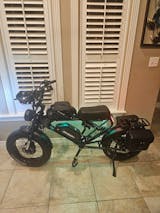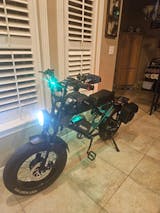Table of Contents
- What Are The Key Differences Between Ebike and Motorcycle-Style Pedal Bikes
- 1. Design & Structure
- 2. Power and Performance
- 3. Speed & Regulations
- 4. Cost & Maintenance
- 5. Riding Experience and Usage
- Pros and Cons of Each Option
- 1. Ebike Advantages
- 2. Ebike Disadvantages
- 3. Motorcycle-Style Pedal Bike Advantages
- 4. Motorcycle-Style Pedal Bikes Disadvantages
- Which One Should You Select?
- Conclusion
- FAQs
An E-bike, also known as an electric bicycle (E-bike), features an assisted pedaling mechanism powered by an electric motor and some models feature throttle controls to allow non pedaled movement of the bike. Ebike are lightweight, easy-ride bikes often used for commuter or leisure travel purposes.
Motorcycle-Style Pedal Bikes look similar to motorbikes but still include pedals. Their larger frames, higher speed capabilities and more powerful motor make these special vehicles the go-to choice for riders looking for maximum propulsion power from their ride. While riders may use the pedals, most prefer using their motor instead for propulsion.
People may often mistake Ebike and Motorcycle-style pedal bikes for one another due to both having electric motors and pedals; however, their differences lie in terms of power output, speed and legal requirements. This guide compares both options so riders can select the appropriate bike for themselves.
What Are The Key Differences Between Ebike and Motorcycle-Style Pedal Bikes
1. Design & Structure
Ebike are created to resemble traditional bicycles while offering riders added electric motor power. Generally lightweight (40 to 70 pounds), riders can switch between manual pedaling and pedal-assist mode easily and switch gears, chains and pedals as needed for smooth operation.
Motorcycle-style pedal bikes typically weigh over 100 pounds and feature heavier frames with sturdy frames. Reminiscent of motorcycles in size, design, and build, these vehicles resemble motorcycles in terms of size, design, tires size, riding stance, pedal use as backup propulsion rather than primary propulsion.
2. Power and Performance
Ebike usually boasts engines between 250 W to 750 W, providing optimal balance between power and efficiency. Many models use pedal technology, where the engine is connected while pedaling, while others can offer a throttle control to allow fully electric driving.
Motorcycle style pedal wheels have motors with power inputs exceeding 1000 W, provide faster acceleration and higher speeds that mimic motorized two -wheel cars closer. Their higher power output often requires licensing and registration in many areas;
3. Speed & Regulations
Ebikes fall into three categories:
- Class 1: Pedal-assist only, 20 mph max speed.
- Class 2: Throttle-assisted, 20 mph max speed.
- Class 3: Pedal-assist only, 28 mph max speed.
In many regions, pedal bikes that exceed 30 mph fall under motorcycle regulations and may require a license, insurance policy and registration depending on local laws.
4. Cost & Maintenance
Ebike are generally less costly, with models typically costing from $850 to $3,000. Their maintenance requirements tend to focus on battery care, brakes, and tires.
Motorcycle-style pedal bikes tend to cost more than average bikes, usually starting from more than three thousand dollars. Furthermore, similar to motorcycles they require more maintenance including regular motor servicing and frame durability checks.
5. Riding Experience and Usage
Fallen Ebike offer an ideal way for urban commuting, fitness training and casual riding alike. Easy to operate with both manual and electric-powered travel capabilities combined together in one package - they make for the ideal commute.
Motorcycle-style pedal bikes offer better long rides and faster travel than their pedal bike counterparts, offering greater power and stability for off-road adventures or highway use.
Pros and Cons of Each Option
1. Ebike Advantages
- Affordable and Cost-Effective: Ebike are more cost-effective than their motorcycle-style pedal bike counterparts, starting as low as $800. Plus, their energy use is considerably reduced; charging will only cost pennies per ride!
- Lightweight and Easy to Ride: Most Ebike weigh 40 to 70 pounds, making them easy to transport and store. Riders can pedal manually if the battery runs out.
- Legal and Accessible: Ebike can be legal and accessible options in many locations without needing licenses, insurance policies or registration; making them ideal for daily commuter use.
- Great for Exercise: Ebike provide excellent exercise opportunities, offering pedal assist that allows riders to maintain an efficient workout with less strain on their bodies while riding. Ebike make perfect fitness gear.
- Eco-Friendly Commuting: Ebike produce no emissions, providing an eco-friendly alternative to gas-powered vehicles.
2. Ebike Disadvantages
- Limited Power and Speed: Most Class 3 models only reach 28 miles per hour - this may not meet riders' high-speed travel needs.
- Battery Range Varies: Ebike typically cover anywhere between 25 to 70 miles on a charge depending on battery size, terrain type and rider weight; long trips may necessitate frequent charging sessions.
3. Motorcycle-Style Pedal Bike Advantages
- Higher Speed and Power: These bikes often contain 1000 W+ engines that allow them to reach speeds above 30 mph for exciting driving with quick acceleration.
- Better for Long Distances: Motorcycle -style bikes increase long -distance travel efficiency thanks to larger batteries and powerful engines, which provides greater efficiency during commuting or road trips.
- Strong Build for Off-Road Performance: These bikes have stronger tires, robust frames and suspended systems that provide maximum off -road performance on bumpy terrain and uneven roads.
4. Motorcycle-Style Pedal Bikes Disadvantages
- Requires Licensing and Registration: In many locations, these bikes must be registered, licensed and insures as per motorcycle law as a result of their higher speed and motor power.
- Heavier and More Expensive: At an average weight of 100+ pounds, these bikes are more difficult to transport and maneuver. Furthermore, their cost starts at an estimated starting point of over $3,000.
Both options offer distinct strengths and drawbacks; selecting the ideal one depends on riding needs, budget considerations and local regulations.
Which One Should You Select?
Its Selecting between an E-Bike and Motorcycle-style pedal bikes depends on your lifestyle, riding needs, and budget. Both options have advantages that may make one better suited to commuting, exercise or high speed travel.
1. Select an Ebike If:
- You require an affordable and practical commuter bike: Ebike offer lower maintenance and operating costs than cars or motorcycles and provide cost-effective daily transport solutions.
- Legal considerations: Ebike offer legal-friendly alternatives. Most cities and states don't require licensing, registration or insurance - making them more convenient to use in many locations than traditional bicycles. Plus they allow riders greater freedom when riding bike lanes or shared pathways.
- Are You Prefer a Lighter and Versatile Ride: An ebike offers weights between 40 and 70 pounds which permits easy storage together with effortless transportation and maneuverability within restricted urban areas.
- Are You Enjoy Casual Riding or Exercising: Ebike users who want a combination of casual riding experiences and exercise benefits have pedal assist features which reduce strains on their bodies during their physical activities.
2. Choose a Motorcycle-style pedal bike if:
- If you need more power and speed: These bikes boast motors of 1000W or greater that allow them to reach speeds exceeding 30 mph, making them great for long-distance travel on roads or highways.
- You want an Electric Motorcycle Experience: These bikes provide powerful motors, larger frames and robust builds resembling electric motorcycles.
- Don't Mind Additional Legal Requirements: Some regions require licenses, insurance and registration which could add extra costs and paperwork.
Before choosing, take time to research local regulations, consider your budget, and think carefully about where and how you plan to ride.
Conclusion
Both Ebike and Motorcycle-style Pedal Bikes offer unique advantages, though they serve different functions. Ebike are more cost effective, lightweight and easy to ride - perfect for commuters, exercise and city travel - with few legal restrictions and greater accessibility than their counterparts.
Motorcycle-style pedal bikes provide faster speeds, powerful motors, and an authentic motorcycle riding experience. These bikes may be more suitable for longer driving and off -road performance, but may require registration, insurance and licenses depending on where you live.
Make your selection between e-bikes or motorcycle-styled pedal bikes by evaluating budget items as well as riding requirements and following local legal requirements to find the best match for your living needs. A person concerned about eco-friendliness will choose an e-bike whereas those requiring high speed and power should select an motorcycle pedal bike. Select the equipment that best matches your current way of living.
FAQs
1. What Are Ebike and Motorcycle-Style Pedal Bikes Differently?
Ebike is usually defined as a bike equipped with an electric motor that helps pedaling, often boasts light frames. On the contrary, motorcycle pedal wheels resemble motorcycles more closely due to their more robust design and more powerful engine, often including secondary pedals to their motor performance.
2. Are Motorcycle-Style Pedal Bikes suitable for off-road use?
Yes, many pedal bikes in the style of motorcycles are built for off -road adventures and are equipped with robust frames, suspended systems and powerful engines that are capable of performing rough terrain and steep tendencies. However, first check the manufacturer's specifications to make sure the off-road compatibility.
3. What are the differences in maintenance requirements between Ebike and Motorcycle-style Pedal Bikes?
Ebike typically require less upkeep, with regular bicycle component care and battery management being sufficient to maintain them. On the other hand, Motorcycle-style pedal bikes need additional care due to their complex systems and higher performance capabilities - this may include motor servicing as well as attention paid to motorcycle-grade parts.




















